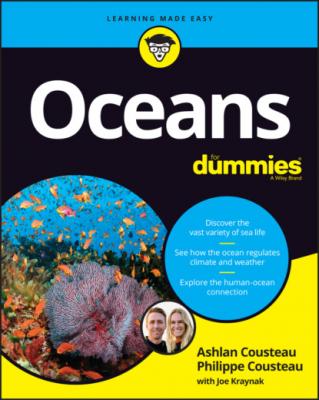Oceans For Dummies. Joseph Kraynak
Читать онлайн.| Название | Oceans For Dummies |
|---|---|
| Автор произведения | Joseph Kraynak |
| Жанр | География |
| Серия | |
| Издательство | География |
| Год выпуска | 0 |
| isbn | 9781119654452 |
How low can you go? The hadalpelagic zone
The deepest zone in the ocean is the hadalpelagic zone (also called the trenches), which is anything deeper than 6,000 meters (about 20,000 feet) below the surface, such as in the deep ocean trenches. This realm is named after Hades, the Greek god of the underworld. We don’t know much about this zone, because it’s hard to get to and requires super specialized technology to cope with the immense pressure.
Source: Woods Hole Oceanographic Institution, P. Caiger – www.whoi.edu
FIGURE 4-11: Viperfish (Chauliodus sloani) — look at those teeth!!!
Life becomes very limited in this zone. You can find giant, single-celled xenophyophores, deep-sea microbial mats, amphipods, sea cucumbers (see Figure 4-12), jellyfish, and other invertebrates such as tube worms (see Figure 4-13), decapods, bivalves, and sea-anemones. Species of snailfish, cusk eels, and eelpouts can also be found in this region but are limited to relatively shallow areas, and usually closer to the seafloor. And even though it is really hard for people to venture this far down, our trash manages to find a way — namely, our plastic. Yup, even here in the deepest part of the ocean, recent expeditions found a plastic bag at one of the deepest points of the Mariana Trench, nearly 11 kilometers (about 7 miles) down. Ugh.
Source: Schmidt Ocean Institute – www.schmidtocean.org
FIGURE 4-12: A sea cucumber.
Source: Woods Hole Oceanographic Institution, P. Caiger – www.whoi.edu
FIGURE 4-13: Tube worms.
Acknowledging the Existence of Other Zones
Oceanographers have come up with other terms and concepts for understanding ocean zones that may be more useful in certain contexts. These other zones don’t contradict the horizontal or vertical zones we present in the previous sections. They just provide a more general breakdown that may be easier to remember and use in dinner conversations. Knowing a little about these zones is also useful in case you encounter the terminology in the context of other discussions.
From light to dark: The photic and aphotic zones
The photic zone is basically the same as the epipelagic zone — the topmost 200-meter (650-foot) layer of the ocean. Personally, we prefer the term photic over epipelagic, because it’s more descriptive (photic means related to light), easier to remember, and easier to pronounce. As with the epipelagic zone, the photic zone describes the layer of the ocean that has enough light for plants to grow.
Aphotic is the opposite of photic. It is the absence of light or, more precisely, insufficient light for plants to grow, which describes about 90 percent of ocean water from 200 meters deep to the seafloor. In the aphotic zone, animals can’t rely on plants to anchor the food web. If they want to eat, they have three options:
Eat the table scraps that drop down from the photic zone.
Eat their neighbors (prey tell!)
Move to vent systems on the bottom (these are few and far between) where chemosynthetic bacteria (instead of plants) called chemoautotrophs anchor the food web. (Chemoautotrophs get their energy from oxidizing inorganic compounds instead of capturing energy from the sun through photosynthesis. Photoautotrophs capture energy from the sun through photosynthesis.)
From top to bottom: The pelagic and benthic zone
One of the simplest ways to section off the ocean is to divide it into top and bottom — the top being the pelagic zone (nearly all the water), and the bottom being the benthic zone (consisting of a relatively thin layer of water above the seafloor, the seafloor itself, sediment, and some subsurface layers).
Organisms may be classified as either pelagic or benthic. Pelagic organisms inhabit the open sea and surface of the ocean, whereas benthic organisms hug the bottom. Species like corals, seagrasses, mollusks (oysters, mussels and the like), crustaceans (crabs, barnacles, and so forth), and fish like rays and flounder are benthic; basically anything that’s attached to the bottom or spends most of its life crawling or swimming along the bottom is considered benthic. All other organisms that float or swim are pelagic.
Конец ознакомительного фрагмента.
Текст предоставлен ООО «ЛитРес».
Прочитайте эту книгу целиком, купив полную легальную версию на ЛитРес.
Безопасно оплатить книгу можно банковской картой Visa, MasterCard, Maestro, со счета мобильного телефона, с платежного терминала, в салоне МТС или Связной, через PayPal, WebMoney, Яндекс.Деньги, QIWI Кошелек, бонусными картами или другим удобным Вам способом.
